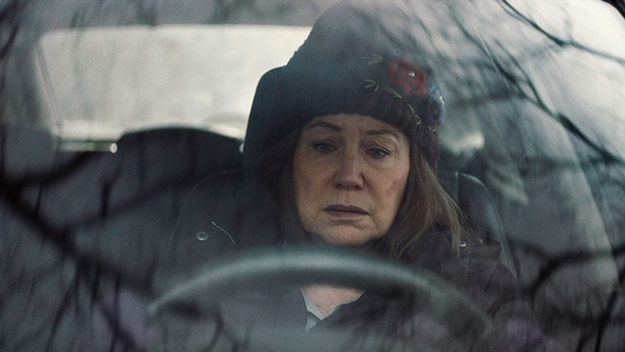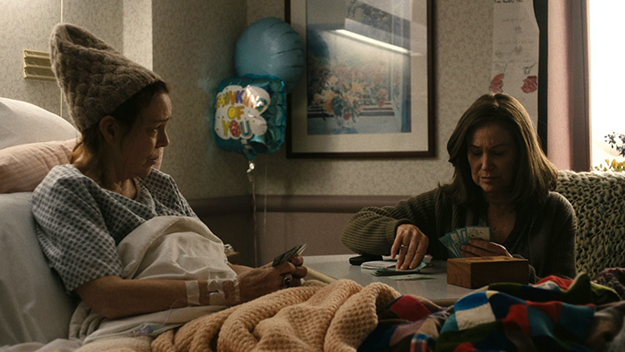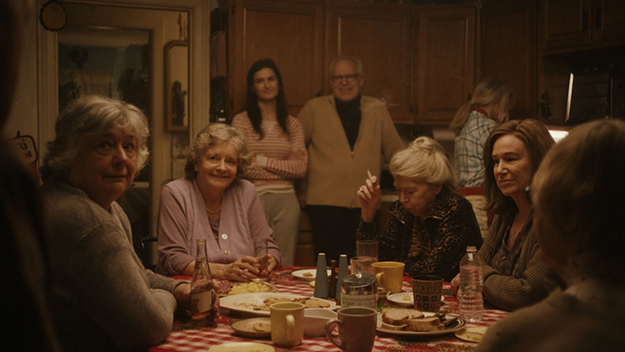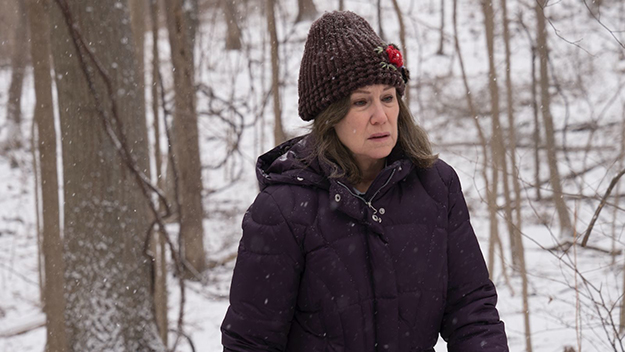Film of the Week: Diane

They’re not the easiest films to get made, dramas focusing on women well into middle age; and if you try to make one, it’s probably safe practice to provide an upbeat payoff. Witness Sebastián Lelio’s fine Gloria, where the exuberance paid off in the form of an English-language remake. Diane, however, is a much tougher call, so don’t expect a moment of dizzy disco-floor release—although the heroine of Kent Jones’s drama does have a barroom moment when she lets herself soar a little to Bob Dylan and Leon Russell numbers on the jukebox. But this is an altogether sober film, a drama about ageing that is nothing less than ice-water unsentimental.
This is the first fiction feature from Jones, whom you’ll know as a long-term critic on this publication, director of the New York Film Festival, documentary collaborator with Martin Scorsese, and director of his own Hitchcock/Truffaut. If you’re a film critic venturing behind the camera, there’s the danger of making a statement in which whatever you know about life is too much filtered through, even obscured by, the mass of cinema that has informed your aesthetic and your way of comprehending the world. Coming from another critic, the following statement may seem perverse, but one of the merits of Diane is that it comes across as the work of someone who doesn’t worry excessively about film; after all, it’s about people for whom cinema doesn’t appear to be any kind of significant factor in life. Indeed, Diane engages with certain aspects of life (certain very unfashionable aspects) in a very direct way that is seemingly very little mediated by a preoccupation with film.
Seemingly, that is—for Diane could only have been made by someone who has absorbed the cinematic lessons of a lifetime to the point where cinema (“mere” cinema, if you like) ceases to be a distracting issue. Style as style is very much underplayed for a large part of the film, which seems to function in a pragmatic mode of everyday realism—only for style to reassert itself later to startling effect. When it does, the film shifts into a very different mode, making you see all its discontinuities and ellipses in quite another light.
Set in rural Massachusetts, the film follows Diane (Mary Kay Place), a woman who lives alone and spends most of her time tending to others, including the people in her family. Her adult son Brian (Jake Lacy) lives in his own run-down place amid chaos and crumpled bedspreads, with a drug habit he’s unwilling to acknowledge, greeting his mother’s solicitude with belated adolescent rage and paper-thin lies about bronchitis. Diane’s cousin Donna (Deirdre O’Connell) is in hospital battling with cervical cancer. And Diane herself works as a volunteer in a kitchen serving food to the homeless, together with her friend Bobbie (Andrea Martin). It’s Bobbie who eventually steps in and reminds Diane to take it easy on herself, something she seems fundamentally disinclined to do. The first time we see Diane, in fact, we instantly sense how far she stretches herself: she’s seen dozing at Donna’s bedside, and it’s her ill cousin who leans over, asking her visitor if she’s all right.

Diane is clearly that thing that cinema generally finds it so difficult to get a purchase on—an ordinary good person. But her desire, her need, to help others is fueled by something in her life for which she refuses to forgive herself: in the diary we eventually see her writing, she calls it “my one terrible sin.” We don’t learn what it is for a while; at first we only know that it happened at the Cape two decades earlier. It’s a transgression that affected at least three people in her life; it’s also the sort of act that another film might have made light of or even celebrated as a moment of necessary self-realization. What Diane shows is that, in life, people don’t always think in the logic of movies, and this episode continues to scratch away in Diane’s psyche, the quiet continual buzz of torment that in some ways defines her—certainly defines her to herself, in a painful way that we can’t possibly feel she deserves.
But Diane is less directly about her secret than all the mundane everyday circumstances that perhaps allow her to forget it sometimes. These are the immediate problems in her life, like Brian, and the passing moments that provide solace from them—chats with Bobbie, visits to older members of her family and circle (played by Estelle Parsons, Joyce Van Patten, Phyllis Somerville), a moment at which a visitor to the kitchen helps Diane tidy up. Then there’s the moment she gets drunk in the bar, letting the mask of calm control slip, and we can see how much she needs it; it’s a wonderful, ultimately painful sequence, beautifully played by Place as she awkwardly sways, struts, in a stiff, rather robotic manner that suggests Diane hasn’t let her body voice its own needs for a long time.

In Diane’s scenes with Brian, the film eschews all clichés about tough love: what we see is just raw conflict that never seems to be heading towards resolution. But the redemption that does come is even worse. In one of the surprise ellipses that come increasingly to determine the film’s rhythm, we find that Brian has kicked his habit and married a young woman, Tally (Celia Keenan-Bolger), from his church. A dinner table scene in which the radiantly beaming, squeakily soul-cleansed young couple attempt to win Diane for their fold, offering her “the gift of revelation” (“Revelation!” sighs Tally) is intensely painful, an uncynical but quite brutal depiction of the cold coerciveness of evangelicals.
Jones and editor Mike Selemon develop a distinctive syntax: the film is dominated by short scenes, often just slivers of episodes, sometimes stacked up repetitively and linked by through-windshield shots of Diane’s car journeys. It’s disconcerting, until we fully comprehend the fragmentary nature of a life taken up by endless shuttling between disconnected islands of time. Diane mainly travels between other people’s places and crises, with very little space to be herself alone—except in the bar, in a solitary walk through a snowy forest and in her nights at home with the diary and a volume of Emily Dickinson.
As the people in Diane’s life start to disappear without warning, the film catches a telling visual and narrative equivalent of the nature of old age. This is ageing seen as a state of intensifying discontinuity, inexorably speeding up, in which the meaning of everything in a life might become inextricable from one decisive moment in the past. Textures of light in Wyatt Garfield’s photography reveal how reassuring and enclosing Diane’s world can be (warm glows of indoor lighting, an enveloping gauziness) but also how forbidding, in its registers of greyness and chill.

A startling moment comes, fairly late in the film, where we discover something more about Diane’s critical moment: it’s done as a dream sequence, followed by a series of disconnected flashes, seemingly from Diane’s memory. This sequence abruptly rewrites the film’s meaning as drastically as a similar shift late in the action transformed Paul Schrader’s First Reformed. Indeed, Diane carries some echoes of Schrader in his serious mode, although it’s perhaps closer to Affliction in its wintry feel; at any rate, both he and Jones are adepts of Bresson, and this story of solitary endurance is perhaps Jones’s Mouchette.
For much of the film, Mary Kay Place’s extraordinary performance gives away nothing, or next to nothing—the lines on her face form a hardened mask, protecting her against the world, but also holding in her disappointment and self-directed rage. It’s some time before the exterior starts to yield but when they come, her moments of fury are phenomenally effective—an argument with a judgmental co-volunteer, the dinner-table face-off with Brian and Tally, that awkward dance that reminds us (and Diane) of the traces of a youthful existence that too easily vanish behind the visible appearance of an elderly one.
We usually expect that a film named after its protagonist will sooner or later reveal everything about that person, give us the whole woman; Diane, by contrast, comes in pieces, as if what we’re seeing is only the tattered remnant of a self, holding itself uneasily together against the ravages of sorrow and time. Its glimpses of an enduring vitality amid the routine and the toil come in little moments of subtly calibrated rhythm—as in the quietly snappy bedside conversations between Place and O’Connell’s Donna, or the spiky, robust humor of the family doyennes.
There’s a sharp winter chill to much of the film’s music, including a score by Jeremiah Bornfield that takes its cue from Ralph Vaughan Williams, with notes of tuned percussion and glass harmonica, as well as Steve Reich and a glacial John Cage piano piece. Discussing the film in this magazine, Jones also mentions two much warmer songs that set a keynote for the film, neither of them actually on the soundtrack: they are two late Dylan titles, “Honey Babe” and “Floater.” But there’s another song of his, also absent here, that inescapably comes to mind as Diane draws on: for this is a picture of a life in which it’s not dark yet, but it’s getting there.
Read Kent Jones on the inspirations for Diane in the March-April issue of Film Comment.
Jonathan Romney is a contributing editor to Film Comment and writes its Film of the Week column. He is a member of the London Film Critics Circle.







